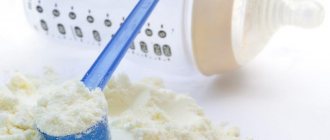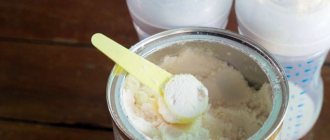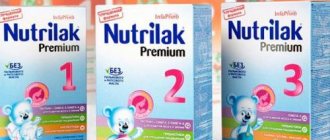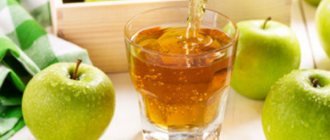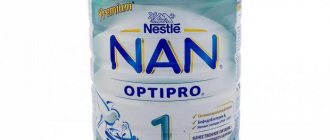Breast milk is ideal for newborns. However, what to do if for some reason a mother cannot breastfeed her baby. In this case, a special milk mixture will help. Artificial feeding should fully replenish the baby's need for vitamins and minerals similar to those that come from mother's milk. Therefore, such nutrition should be monitored carefully.
Quite often situations arise when you need to change the formula for feeding. This should be done correctly and wisely. Let us dwell in more detail on the question of how to introduce a new mixture to an infant.
When to introduce supplementary feeding to an infant
Let's look at under what conditions it is not necessary to introduce supplementary feeding during breastfeeding, and what circumstances force the introduction of formula into the child's diet. Let's start with what mothers put forward as arguments for introducing supplementary feeding and, by the way, some doctors are influenced by this evidence.
Frequent reasons for introducing supplementary feeding
Often, young mothers, due to doubts in their abilities, make a mistake, which is based on the beginning of supplementary feeding in the early stages. This happens in the postpartum period, at a time when the volume of breast milk has not stabilized, and it feels like the baby is not getting enough. This situation is aggravated by the baby’s crying, which the mother interprets as the baby’s request for additional nutrition.
After taking the mixture, the baby calms down and sleeps well. And thus, an erroneous opinion is formed about the need for mandatory supplementary feeding. Plus, some mothers are too lazy to breastfeed, and some develop cracks in their nipples, which causes pain during feeding, and supplementary feeding seems to them to be a way out of this situation.
Note!
According to physiological data, immediately after childbirth the amount of milk is always small, and this is the norm. In addition, during this period, the baby’s kidneys are still “immature”; they are just beginning to adapt to existence in the external environment and, due to their functional abilities, are not able to process large volumes of liquid. Therefore, a woman’s body produces special milk - colostrum. Colostrum has a very thick consistency, there is little of it, but it sufficiently satisfies the needs of the newborn. From the 5th day after birth, transitional milk begins to be produced, which already becomes more liquid; in order for lactation to be good, it is necessary to put the baby to the breast as often as possible. The properties and composition of breast milk are discussed in detail in another article on our website.
When supplementary feeding is not required
Conditions that indicate there is no need to supplement the baby's feeding:
■ If the baby behaves anxiously at the mother’s breast. This situation does not always mean the absence or insufficient amount of breast milk. This concern may be associated with the baby’s confusion and inability to handle the nipple; the child may have colic or something else. The pediatrician must examine the child and if everything is in order health-wise, then this situation can be sorted out by eliminating nipples and pacifiers, which form an unnatural way of grasping the nipple, as well as by frequently putting the baby to the breast.
■ Also, one of the factors that causes a child to cry is the pathological structure of the tongue, which manifests itself in the presence of a short frenulum. This deficiency does not allow the baby to latch onto the breast naturally.
■ Repeatedly putting a baby to the mother's breast is a normal physiological need of the child's body, and does not at all mean that the baby is hungry and needs additional complementary feeding.
■ The volume of expressed milk does not regulate the rules for introducing additional complementary foods. If the baby is breastfed, there is no need to pump.
■ According to WHO proposals, the beginning of supplementary feeding is not rational for children under six months of age who are fed breast milk, as well as supplementing infants with water. The use of mixtures is carried out only for medical reasons, and after consultation with a pediatrician.
When should you supplement your baby?
Situations that determine the need to introduce additional formula feeding of infants:
■ If the child was born before the due date. Due to weakness, premature babies are unable to breastfeed independently. In such a situation, supplementary feeding contributes to the rapid recovery of the child’s body.
■ Presence of neurological pathologies. Infants with this diagnosis cannot coordinate their actions to latch onto the nipple correctly. Diagnosis of these pathologies occurs in the maternity hospital and upon discharge, parents have a number of recommendations for the introduction of formulas for feeding the child.
■ Insufficient amount of breast milk (hypolactation). Proper organization of breastfeeding and adherence to the breastfeeding regime will allow you to normalize the amount of milk and subsequently abandon mixed feeding.
■ As practice shows, supplementary feeding with formula during breastfeeding is a temporary phenomenon. The main task for a young mother at this stage is to maintain lactation and exclude the possibility of transferring the baby to artificial feeding.
■ Constantly spending time with the baby, tactile contact, joint rest and sleep with the baby, as well as unlimited attachment of the baby to the mammary glands will increase the amount of breast milk to the required norm.
What to give a baby formula from
If, as a result of a consultative examination, supplementary feeding is prescribed by a pediatrician, first of all you should take seriously the selection of the necessary utensils for feeding. The most common mistake in this case is the use of a classic container in the form of an ordinary bottle with a nipple for feeding. But as experts have proven, this approach to supplementary feeding can ensure that the baby completely refuses natural feeding, which involves the need to put in more effort than when feeding formula from a bottle. This is because the way nipples are latched and pacifiers are quite different, despite companies claiming to create nipples with an ideal anatomical shape. At the moment, rubber products that would completely replicate the female nipple have not been created. Therefore, a baby who is supplemented with formula through a bottle sooner or later has to make a choice and, as a rule, it is not in favor of the breast.
The differences between breastfeeding and a pacifier and bottle are very significant and are as follows:
— Grip depth.
When breastfeeding, the baby should grasp the nipple completely with the areola, while obtaining food through the nipple does not require a deep grasp.
— Amount of effort.
The supply of food from the nipple occurs easily and unhindered, which cannot be said about the natural way of feeding. When extracting milk from the mammary glands, the baby will have to make a lot of effort; some babies even sweat when they suckle.
— Functionality of gums and tongue.
When breastfeeding naturally, the tongue is used. During supplementary feeding, the process of obtaining food is carried out by chewing with the gums.
The ease of feeding formula from a bottle justifies the conditions for the baby to completely refuse breastfeeding. In this case, breast milk is completely replaced with formula, the benefits of which are significantly less than those of breast milk.
You can prevent your baby from refusing natural feeding by using alternative devices designed for supplementary feeding. Let's look at what kind of dishes will not discourage a child from breastfeeding.
How to give formula to a child
— Spoon.
In pediatrics, it is allowed to use an ordinary teaspoon, made of silicone, or a special one combined with a baby bottle for feeding. A half-filled spoon is inserted into the child’s mouth, and its contents are applied to the area between the cheek and gum. After making sure that the baby has swallowed the mixture, you can add the next portion.
— Pipette, syringe.
The feeding rules remain the same. The milk mixture is introduced into the mouth in small portions, but in no case at the root of the tongue. It is recommended to use plastic pipettes with a safe, rounded spout and dispensing syringes made from medications that lower the child’s temperature during fever.
— Beaker.
Miniature variations of this piece of utensils are used, made from materials that are safe for the health and life of the baby. The filled container is applied to the baby’s lower lip and moistened with the milk mixture. After waiting until the child licks his lips, you can reapply the next part of the food. Sometimes children lick the mixture from the beaker with their tongue, like kittens. This technology of supplementary feeding is considered the most common and practical form in infancy.
— SNS technology.
It is supplied with a soft bottle made of silicone-containing plastic and a thin-diameter tube with a lock for holding on the mammary gland. This container is filled with the mixture, the tube is attached to the nipple, to which the baby is applied. This system ensures that breast milk and formula enter the baby’s stomach at the same time.
The SNS system is not very popular in Russian pediatrics. But world experts say that this is the best way to introduce complementary foods. Thanks to its use, tactile contact between the mother and the child is maintained, the function of milk separation by the mammary gland is supported, and the consumption of milk formula is ensured in an amount that meets the child’s needs.
All utensils and equipment for feeding a child must be sterilized before each use; regular washing is not enough. The dishes should be boiled or kept over steam, but it is best to use a special sterilizer for jars.
Rules for introducing the mixture
Any method of introducing supplementary feeding requires strict adherence to the following conditions:
- Putting the baby to the mother's breast immediately before and immediately after additional feeding.
— The beginning of the process of feeding a child should only be carried out in a calm state, both mother and child.
— Strict adherence to serving dosage.
- Avoid force feeding.
No objects for introducing complementary foods can compensate for the sucking reflex. Accordingly, regular breastfeeding will solve two problems at once:
— realization of the baby’s need for sucking;
- additional stimulation of the functioning of the mammary glands.
Increasing the volume of lactation will allow you to completely abandon supplementary feeding in the shortest possible time. Increased lactation can be achieved by taking medications and natural lactation stimulants.
How to give formula to a child correctly
In order for a child to gain weight correctly (the table of weight gain for a child up to one year is displayed on our website), you need to know exactly how much breast milk the child will not receive. Previously, pediatricians relied on established standards, which stated: at two months of age, supplementary feeding during breastfeeding should not exceed 60 grams per day, at 3 months - the norm is 90 grams, and at six months of age - 240 grams. However, these indicators do not always correspond to the real needs of the child.
This is due to the fact that such standards do not take into account the volume of breast milk produced. This method often led to the child being completely transferred to artificial feeding. Therefore, European experts from the La Leche League Internftional and AKEV associations recommend abandoning this scheme and following the following tactics when calculating the volume of supplementary feeding, which is based on counting urination per day. The norm for a baby to urinate per day is 12 times; it has been established that this amount is released with sufficient food intake. Therefore, this check is extremely necessary when introducing supplementary feeding. The amount of formula required for supplementary feeding is calculated using the following formula: the number of urinations not performed is multiplied by grams corresponding to the child’s age.
1 month - 10 grams 2 months - 20 grams 3 months - 30 grams 4 months - 40 grams 5 months - 50 grams 6 months - 60 grams.
In addition, it is necessary to stimulate the secretion of milk by the mammary gland. This is done by frequent breastfeeding, excluding nipples and pacifiers, and night feeding, in particular in the period from 3 to 8 o'clock. If the child urinates more than 12 times a day, the volume of the formula should be gradually reduced, until complete refusal.
Product names
The mixture is selected taking into account the individual characteristics of the newborn. You can choose the right baby food using the table:
READ ALSO: How to choose hypoallergenic formula for newborns?
| Individual characteristics of children | Titles |
| For healthy children |
|
| With stool retention |
|
| Intolerance to cow's milk |
|
| Allergic reactions to food additives |
|
| With frequent regurgitation |
|
If you are allergic to cow's milk, mixtures containing soy are prescribed:
- Heinz;
- Enfamil;
- Tutelli;
- Nutrilon.
Cheaper products include Malysh, Nutrilak, Agusha, Babushkino Lukoshko, Malyutka, Semilak, Nestozhen.
Supplementary feeding scheme
The scheme for introducing supplementary feeding to a child can be carried out according to two principles, the first is better for newborns, and the second for infants.
1. By sleep.
The daily dose of the mixture is divided into equal parts, which are given to the child before bedtime and immediately after waking up. This scheme requires increased control over obtaining the entire daily volume of the mixture per day.
2. By the hour.
The daily volume of the mixture is divided into 5 parts. Feeding should be done every 4 hours, starting with morning feeding. At night, it is recommended to refrain from supplementary feeding with formula; it is better to offer the baby the breast.
Rules for a healthy transition
Materna specialists recommend a step-by-step scheme for switching to a new diet within one week, the frequency of feedings is 7 times: 1 day: the first feeding - only the old formula, the second feeding - the new one, the remaining feedings - the old formula. Monitor the child’s condition; there should be no anxiety or sleep disturbances; Day 2: new formula – second and fourth feeding times; Day 3: new formula - second, fourth and sixth feedings; Day 4: new formula - first, second, fourth and sixth feeding; Day 5: new formula - first, second, third, fourth and sixth feeding; Day 6: new formula - every feeding except the fifth; Day 7: each feeding - a new mixture.
Such a smooth transition will help the child’s body easily adapt to the new diet, which will prevent digestive problems or other negative consequences for the baby’s health.
conclusions
The urgency of the problem of introducing supplementary feeding during breastfeeding is solved by an integrated approach, which takes into account many indicators (weight gain, health status, allergies, number of urinations). Please note that you cannot administer the formula to your child yourself; only a pediatrician can recommend supplementary feeding if there is an indication for this. During supplementary feeding, it is necessary to eliminate all errors in breastfeeding (increase the frequency of latching, master the technique of proper nipple latching, abandon the pacifier and pacifier, maximize the amount of time spent with the baby, take drugs that increase lactation), and the correct selection of the volume of formula consumed will ensure the child with the missing food until lactation normalizes. Remember, if the frequency of urination corresponds to the norm, supplementary feeding is not required, even though the baby is not gaining weight, unless, of course, there are medical indications for supplementary feeding.
Date: 02/17/2016
The main pros and cons of artificial feeding
Before switching to formula, you should weigh all the positive and negative aspects of such feeding.
The main advantages when choosing an individual entrepreneur:
- The child can be fed by other relatives. At this time, mom can go about her business or even work. The child will not suffer from hunger.
- When feeding from a bottle, the mother can always estimate the amount of food eaten and will immediately pay attention to poor health if the baby begins to eat poorly.
- An allergic reaction is usually associated with artificial formula. In this case, you can replace the IP, and there is no need to revise your diet.
- The baby remains full for a longer period because the formula takes longer to digest.

